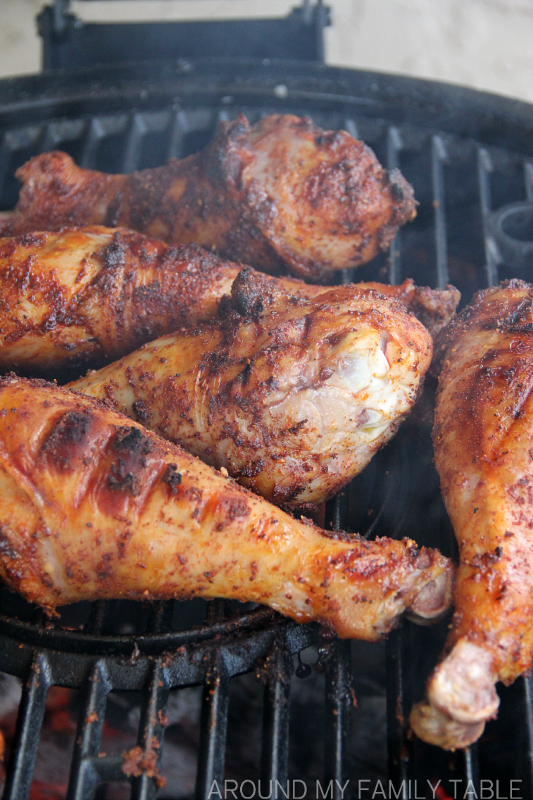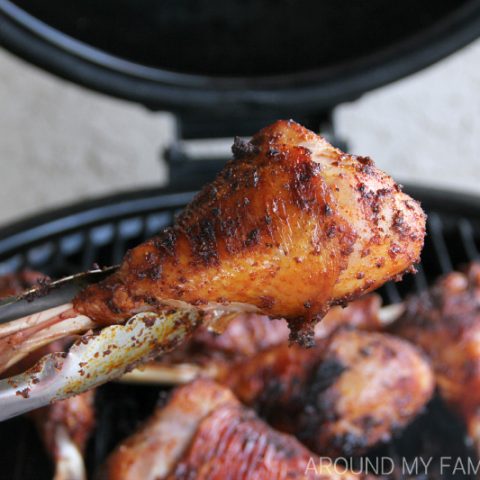Kids all over the world will love these Giant Fair-Style Turkey Legs. They are sweet and spicy, and they’re even better than the fair.
Every year we go to the Renaissance Festival and my daughter freaks out over the giant turkey legs. She absolutely loves them…they are a special treat for her. In fact, we recently had one when we were at Animal Kingdom at Walt Disney World. My momma heart melted when I saw the joy on her face when she realized she would be able to eat a second giant turkey leg in one year. I knew I had to figure out how to make them at home for her.
That sounds great! Before I give you the recipe, I want to talk about the wonderful trip I recently took to a turkey farm in Virginia.
I recently spent some time at one of Shady Brook Farms’ and Honeysuckle White’s turkey farms that is run by a family. The Miller family was very kind and let me stay in their home. They told me how much they love raising turkeys.
The baby turkeys are only 10 days old here and they were so curious…. our family chickens aren’t even this interested in us. They were so cute and I totally wanted to smuggle a couple in my luggage to take home.
Don’t freak out…. I told you these babies were super curious. When I got down on my knees to take a picture, they all ran over to me. It looks like a bunch of baby turkeys running at you at the same time. And the brand new barn they are living in is gigantic. We only walked half of it because it’s so big. Most of the time, the babies were right behind us.


Giant Fair-Style Turkey Legs
Yield: 6 Prep Time: 12 hours Cook Time: 45 minutes Total Time: 12 hours 45 minutes
Sweet and spicy. Kids all over the world will love these Giant Fair-Style Turkey Legs. They’re even better than the fair ones.
Ingredients
BRINE
- 1/2 cup table salt
- 1/2 cup brown sugar
- 2 tbsp onion powder
- 2 tbsp garlic powder
- 2 tbsp red pepper flakes
- 2 tbsp poultry seasoning
- 1 tbsp Tabasco
- 2 bay leaves
- 3/4-1 gallon water
- 6 large turkey legs
RUB
- 2 tbsp chili powder
- 2 tsp steak seasoning
- 2 tsp paprika
- 1 tsp onion powder
- 1 tsp garlic powder
- 1 tsp salt
- olive oil
Instructions
- In a large container with a lid, mix all the brine ingredients together. Then, add the turkey legs. Let sit in brine for 12-24 hours, stirring occasionally.
- Prepare charcoal grill for indirect cooking at about 325F. Meanwhile, remove turkey legs from brine, rinse and pat dry. Mix the rub’s parts (except the olive oil) in a small bowl. Spread a little olive oil on the turkey legs, then sprinkle all of the rub on them and gently rub it in.
- For 45 minutes to an hour, or until the thickest part of the leg reaches 165F, cook over indirect heat at 325F. Turn legs every 10-15 minutes to cook evenly.
- Need more info on charcoal cooking. Read this post to learn HOW TO GRILL WITH A CHARCOAL GRILL.
Did you make this recipe?
A great street painter from South America painted this barn with only spray paint!!!
It was great to spend time on one of the 700 family-owned farms and at the Millers’ home. They were so kind and let us sit around their family table to talk turkey.
What I learned was that these turkeys are not given any growth hormones or antibiotics…. It’s cheaper to keep the area clean and safe for the birds than to give them those things. Can you picture trying to give 25,000 turkeys several rounds of shots? That would be crazy hard to do. And even with all the safety measures, their food does not cost a premium. It’s good food and at a reasonable cost so that everyone has access to delicious turkey.
Do you not love those crazy white suits we had to wear?!?! They kept the birds safe from any germs and diseases we might have brought with us. Avian flu is killing birds all over the country, which is sad. These suits help keep the barns and turkeys clean and healthy. They were quite the fashion statement.
Erika from Musings of Stay at Home Mom and Scarlett from Made It, Ate It, Loved It were the only other women on the trip. We had been online friends for years and were so excited to finally meet in person. Check out their yummy turkey recipes:
Disclaimer: Shady Brook Farms/Honeysuckle White invited me to visit a farm and learn about their turkey. Travel and accommodations were provided and I was compensated for my time and recipe.
As an avid fan of Renaissance festivals, few foods excite me more than a juicy, meaty turkey leg. These giant hunks of smoky, salty poultry have become an iconic treat at these medieval themed events across the country. But just how did this carnivorous novelty become so deeply ingrained in the culture of the Renaissance fair?
The Tasty Origins
While you won’t find historical evidence of peasants noshing on two-pound turkey drumsticks during the time of kings and knights, the popular fare found its beginnings in the very first Renaissance festivals that emerged in the 1960s. These festivals, though more fantasy than historical reenactment, sparked a craze for reveling in the sights, sounds and flavors of a romanticized medieval era.
According to my research, the Renaissance Festival in Waynesville, Ohio claims to sell the largest turkey legs of any fair, with legs averaging around 2 pounds each They go through a whopping 70,000 pounds of turkey per festival season!
It was the turkey leg’s primal, hand-held quality that made it such a perfect fit for these medieval celebrations, even if eating them by the fistful isn’t exactly period-accurate.
Why They Taste Like Ham
While the sight of these colossal, Fred Flinstone-worthy turkey legs provokes awe and delight, their delicious taste is what truly captivates us fair-goers With crispy browned skin and tender, pink-hued meat, the turkey legs have an unmistakably ham-like flavor
This is no coincidence – the preparation process of brining, curing and smoking gives the turkey legs a distinctly ham-like texture and taste. The turkey legs are first wet cured, just like a city ham. This brining in a salty solution deeply seasons the meat and helps it stay juicy when cooked.
After curing, the legs are smoked to impart flavor. This smoking aids in moisture loss, forming a tasty browned exterior, while also allowing smoke compounds to penetrate the meat. The result is smoky, salty and supremely savory meat with a smooth, dense texture like ham.
Keeping it Traditional
For many Renaissance festivals, taking the time to prepare the turkey legs in this traditional, historic style is a point of pride and authenticity. The process connects fair-goers to the salts, spices and cooking methods of the past.
Festivals like King Richard’s Faire in Massachusetts still rely on small-scale turkey farmers and meticulous curing and smoking to produce their famous fare. It may be a bit fanciful, but through this food we can taste history!
Going Beyond the Bird
While giant turkey legs may be the quintessential Renaissance fair treat, they are only the beginning of the bold flavors these festivals have to offer. Here are just a few of the other delicacies I look forward to indulging in every time I step through the village gates:
- Meat pies overflowing with tender beef, vegetable and gravy filling
- Fresh baked bread that fills the air with its heavenly aroma
- Sweet cakes made with dates, nuts, honey and warm spices
- Hearty stews brimming with root vegetables and savory herbs
- Crispy fried potato pancakes known as latkes
- Frozen custard churned fresh at the fair
With so many options for filling your belly and fueling your day of jousting, magic shows and craft browsing, a trip to a Renaissance festival is truly a feast for all the senses. Just be sure to grab a turkey leg to gnaw on as you explore – it’s the perfect edible souvenir!
So for those looking to sink their teeth into history this fair season, keep an eye out for the tell-tale sight of smoke billowing from a food stall. When you spot it, make haste! A fresh batch of succulent turkey legs awaits.

SMOKED TURKEY LEG! (With bonus MEAD review) Renaissance Fair Food Reviews EP. 03
FAQ
Are Renaissance Festival turkey legs ham?
Why are turkey legs associated with medieval times?
What is a turkey leg at the fair made of?
How much is a turkey leg at the Minnesota Renaissance Festival?
